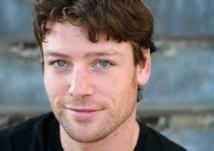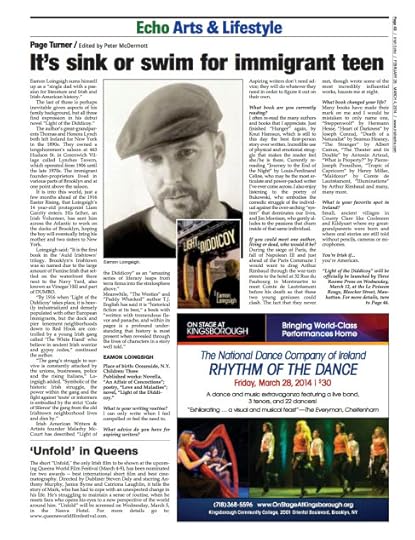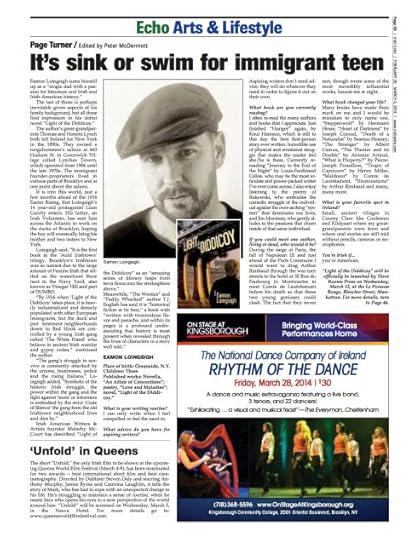Eamon Loingsigh's Blog, page 17
April 2, 2014
Big Momentum
Light of the Diddicoy, the historical novel about Brooklyn’s 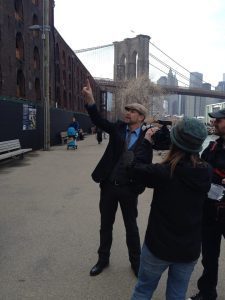 waterfront gangs as told by a 14 year-old Irish emigrant, is continuing to surprise the book industry and gain momentum. New interest is popping up in different areas, including Europe as the Amazon.co.uk release happened recently. Dublin continues to be a hotspot and, surprisingly, London as well.
waterfront gangs as told by a 14 year-old Irish emigrant, is continuing to surprise the book industry and gain momentum. New interest is popping up in different areas, including Europe as the Amazon.co.uk release happened recently. Dublin continues to be a hotspot and, surprisingly, London as well.
Thanks to you, our readers, this book is breaking new ground and turning heads all over the place. Recently, Declan Burke, who runs the most popular Crime blog, called Crime Always Pays, recently featured Light of the Diddicoy here. Apparently, we all thought Light of the Diddicoy was just a “Historical Novel,” but a whole new genre has picked it up and called this book its own in the Crime/Thriller/Mystery circles. Who knew?
Also recently, a film crew followed me around the locations in Brooklyn where the book takes place, such as 25 Bridge Street, which was the White Hand Gang’s headquarters under the Manhattan Bridge and the historic Empire Stores warehousing units (see picture above) in-between the bridges where ships 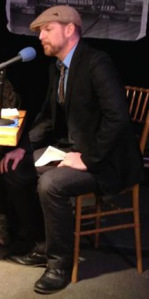 brought in coffee and tobacco that were unloaded by the gang’s longshoremen and housed up in those iron-shutter windows. Earlier in the day, WBAI Radio-NYC host John McDonough interviewed me down at Rocky Sullivan’s in Red Hook about the book and the Irish Republican and New York history featured in it. Afterward, the camera crew and many others followed us to sell copies of the book at Spoonbill & Sugartown Booksellers up on Bedford Avenue in Williamsburg.
brought in coffee and tobacco that were unloaded by the gang’s longshoremen and housed up in those iron-shutter windows. Earlier in the day, WBAI Radio-NYC host John McDonough interviewed me down at Rocky Sullivan’s in Red Hook about the book and the Irish Republican and New York history featured in it. Afterward, the camera crew and many others followed us to sell copies of the book at Spoonbill & Sugartown Booksellers up on Bedford Avenue in Williamsburg.
Finally, we are closing in on readings at Quinnipiac University-Ireland’s Great Hunger Museum and in Hartford, CT, Oceanside, New York (where I was born!) as well as a few in the Mid-Atlantic regions and in Tampa and St. Petersburg, Florida.
But first, I am honored to be reading with Terry Golway, an established writer and Kean University professor, historian and author of the great non-fiction book that was recently released called Machine Made which redefines Tammany Hall’s role in New York City politics. 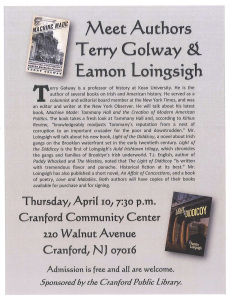
~~~~~~~~~~~~~~~~~~~~
For more information about Light of the Diddicoy, or to request interviews and schedule readings/appearances, please contact Three Rooms Press at info@threeroomspress.com.
Get your copy at a local bookstore, or go here at amazon or here at Barnes & Noble.


March 28, 2014
Excerpt from Ch. 6 Light of the Diddicoy
Posted on March 25, 2014 by eamonblog
At the bottom of this post is a link to a SoundCloud file from Chapter 6 of Light of the Diddicoy.
I don’t believe in long, boring readings where you have to pay close attention to the droning, monotone voice, so I always do my best to keep a listener involved and interested. Trust me when I say you will be shook by this excerpt.
The Tenement Wake – A tenement wake was commonplace in mid-to-late1800s and early 1900s New York City. Too poor to afford a regular funeral home, or, unwilling to trust others with the body of their dead (including the church), people who lived in tenements often had their wake right in their own living room (or “parlor” as it was known then), as is the case in this scene from Chapter 6 of Light of the Diddicoy, which takes place in December, 1915 in a tenement/waterfront neighborhood south of what is called Brooklyn Heights, north of Cobble Hill.
Characters in this excerpt:
Liam Garrity – Narrator, 14 year-old boy from Ireland, taken in by the White Hand Gang.
Dinny Meehan – Leader of the White Hand Gang
Gang Members – The Swede, Vincent Maher, Harry Reynolds, Cinders Connolly
Mother – The mother of McGowan, who was murdered in Sing Sing.
Click here and enjoy
You can find the book here:
https://soundcloud.com/eamon-loingsig...
March 25, 2014
Excerpt from Ch. 6 – McGowan’s Wake
At the bottom of this post is a link to a SoundCloud file from Chapter 6 of Light of the Diddicoy.
I don’t believe in long, boring readings where you have to pay close attention to the droning, monotone voice, so I always do my best to keep a listener involved and interested. Trust me when I say you will be shook by this excerpt.
The Tenement Wake – A tenement wake was commonplace in mid-to-late1800s and early 1900s New York City. Too poor to afford a regular funeral home, or, unwilling to trust others with the body of their dead (including the church), people who lived in tenements often had their wake right in their own living room (or “parlor” as it was known then), as is the case in this scene from Chapter 6 of Light of the Diddicoy, which takes place in December, 1915 in a tenement/waterfront neighborhood south of what is called Brooklyn Heights, north of Cobble Hill.
Characters in this excerpt:
Liam Garrity – Narrator, 14 year-old boy from Ireland, taken in by the White Hand Gang.
Dinny Meehan – Leader of the White Hand Gang
Gang Members – The Swede, Vincent Maher, Harry Reynolds, Cinders Connolly
Mother – The mother of McGowan, who was murdered in Sing Sing.
Click here and enjoy
You can find the book here.


March 21, 2014
Diddicoy Tour & Sales
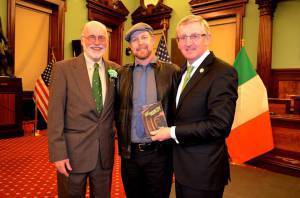
On the left is Peter Quinn, quite possibly the most decorated and recognized Irish-American writer alive today. On the right is Irish Consular General to New York Noel Kilkenny holding Light of the Diddicoy. And then myself in the middle. (photo by Vera Hoar)
Well, there has been non-stop action the past couple of weeks. Light of the Diddicoy has been released to the public and we are getting feedback from people all over the country receiving their pre-ordered copies from Amazon and Barnes & Noble. On March 25, all e-books and Kindle versions will be out as well.
Bookstores everywhere are carrying it too. Here in New York City, copies have been placed “face out” in the front of huge bookstores like The Strand, McNally Jackson, Book Court and Spoonbill & Sugartown. Barnes & Noble, Books-A-Million and other national chains are carrying it in your neighborhood too and even at Moe’s Bookstore in Berkeley, California and Seattle, Michigan and all over the Mid-Atlantic.
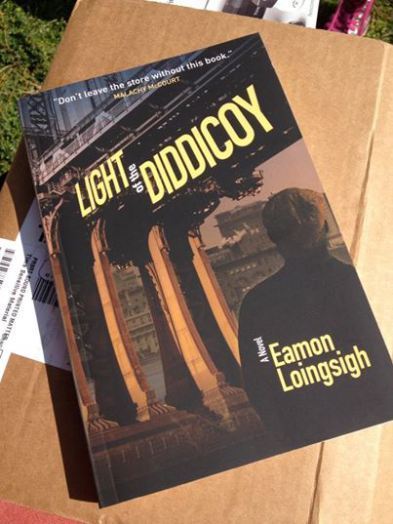
This copy just arrived at Tracy & Keith Kellogg-Brodeur’s home in Wilmington, NC.
Sales have been impressive for a book whose author does not have an established name (yet!). All over the country we are hearing that copies are being bought. If you have been following the progress of Light of the Diddicoy for a while, now is the time to consider spending a bit (less than $16 everywhere) to get your copy. It does not take long and the links on this page will take you right there. Go to your local bookstore and support them and if they don’t have it, ask them to order for you. I don’t enjoy this side of the business, asking for you to go to the store and buy a copy of the book, so I won’t spend much time doing it. But, the hour has arrived. Please, if you would, consider reaching out for a copy. Do it. Thank you.
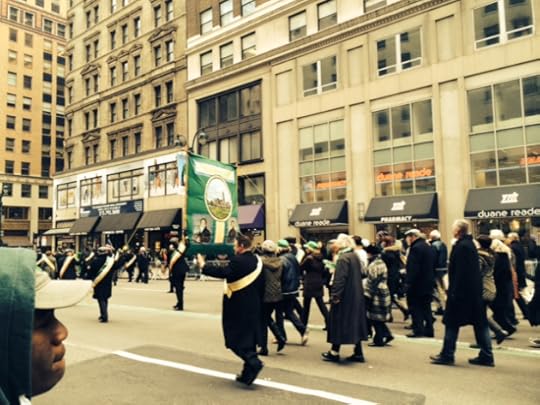
The 2014 St. Patrick’s Day Parade from the corner of 5th Avenue and 44th Street.
I was lucky enough to have taken part in the St. Patrick’s Day Parade as we all braved the cold weather. Tuesday night, I had the pleasure of reading at the Irish American Writers & Artists Inc. Salon at The Cell Theatre. As a member, I was very excited to meet some pretty wonderful people. Larry Kirwin, lead singer of the Irish trad-rock band Black 47 and an officer in the IAW&A was there the night after performing on the Tonight Show With Jimmy Fallon! Mr. Kirwin gave a rousing and supportive speech. Also in attendance was Honor Molloy, the playwright and author of the award winning book Smarty Girl: Dublin Savage. Recent book deals from Carmel Harrington and Kathleen Donohoe show that the Irish are still a very valued ethnic writing group.
The next night, I was lucky enough to attend the Irish Heritage and Culture bash at City Hall in New York City. Two great Irishmen were honored that night and I was lucky enough to have shared the stage with them, if only for a moment. The proceedings were handled with such care and grace that one has to remember that the Irish hold a very dear place in the heart of all New Yorkers. Especially this time of year! St. Patrick’s Day was celebrated with music, dance and corn beef, cabbage and, of course, potatoes.
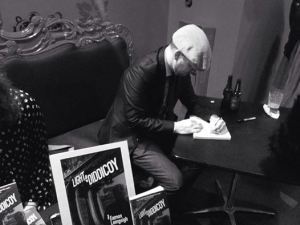
Here I am signing copies at the big launch in Greenwich Village, just a few blocks west of the saloon my family owned from 1906-1978. (photo Marie Flaherty)
After that, I jumped on the train for a reading of Light of the Diddicoy at Jimmy’s No. 43, a hip spot for poets and authors on the Lower East Side of the city at the Guerrilla Lit Reading Series. I can tell I am getting better at my readings. Not only from the reaction of the crowds, but for the fact that I don’t really get nervous any longer! I always try to make my reading as entertaining as possible (I mean let’s face it, readings can be boring), so I read from Chapter 6, which was about an Irish “tenement wake” in Brooklyn circa 1915. The crowd listened intently as I read and I actually got some “oohs” and “aaacchhhs!” when I read the part about the dead gangster boy’s mother drinking his blood. It was great!!!
Tomorrow (Saturday March 22) is the next big gig, however. If any of you can make it, please do! We will be hitting multiple spots in Brooklyn while a 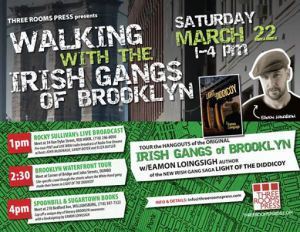 film crew (doing a documentary on me) will be following. First we are at the famous Irish bar Rocky Sullivan’s where I will be doing a live broadcast for WBAI Radio-NYC with host John McDonough. Afterward we will go to the gang’s headquarters in Irishtown at 25 Bridge Street, then over to the Empire Stores between the Bridges. Finally, we will be selling books at Spoonbill & Sugartown bookstore in Williamsburg. It should be a blast and hopefully we’ll sell loads of books.
film crew (doing a documentary on me) will be following. First we are at the famous Irish bar Rocky Sullivan’s where I will be doing a live broadcast for WBAI Radio-NYC with host John McDonough. Afterward we will go to the gang’s headquarters in Irishtown at 25 Bridge Street, then over to the Empire Stores between the Bridges. Finally, we will be selling books at Spoonbill & Sugartown bookstore in Williamsburg. It should be a blast and hopefully we’ll sell loads of books.
Again though, if you would, go to your local bookstore and order a copy of Light of the Diddicoy. If they don’t have it, ask them to order it. Otherwise, use the links below to order online. Now is the time!


March 14, 2014
Diddicoy Release Party
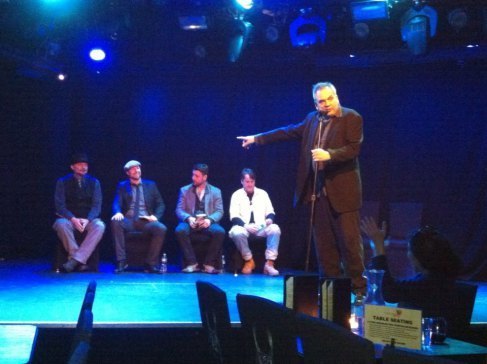
From left to right T.J. English, Eamon Loingsigh, John Duddy, John McDonough and host Peter Carlaftes pointing the way.
We had a great time at the Light of the Diddicoy release! And sold loads of books too. Le Poisson Rouge, in Greenwich Village was an excellent host and it was a full house, filled with Richard Vetere’s friends and lovers of his new release The Writers Afterlife and lots of Diddicoy folks too.
T.J. English, the famous journalist and author of Paddy 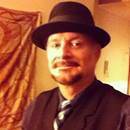 Whacked and The Westies, kicked the night off by talking about the impact Light of the Diddicoy had on him and why gangs were a result of a lack of a social safety net in New York during the era.
Whacked and The Westies, kicked the night off by talking about the impact Light of the Diddicoy had on him and why gangs were a result of a lack of a social safety net in New York during the era.
Afterward, I spoke for a bit about the book, made my “thank yous” and read from the book for a bit. Then WBAI Radio-NYC host of the show Radio Free Eireann and I spoke about what was happening in 1916 Brooklyn, when the book took place 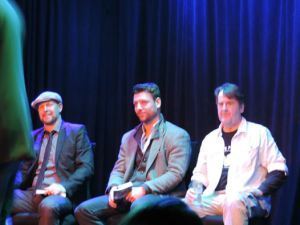 and the Irish historical connections in Light of the Diddicoy.
and the Irish historical connections in Light of the Diddicoy.
John Duddy, the Middle Weight Champion boxer and actor starring in a film called “Hands of Stone” (December 2014 release) next to Robert De Niro, read from the book.
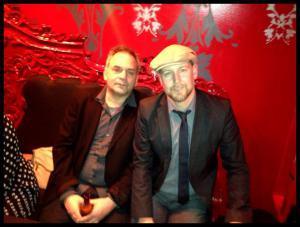
Co-Director of Three Rooms Press, Peter Carlaftes and myself as we sold copies of Light of the Diddicoy after the show.
Afterward, it was book signing time.
Light of the Diddicoy also got a great mention in Declan Burke’s blog Crime Always Pays, here:
http://crimealwayspays.blogspot.ie/2014/03/a-trilogy-grows-up-in-brooklyn.html
And my local newspaper, the Tampa Bay Times ran a piece on the book as well here.
http://www.tampabay.com/features/books/whats-eamon-loingsigh-reading/2169844
Lots of reviews will be popping up soon as well, including The Guardian US, Brooklyn Rail and many others. Heck, there’s even a review at Amazon.com already!


March 10, 2014
“Wild Bill” Lovett, Diddicoy Bad Guy
No true Irish story is complete without treachery from within. The White Hand Gang, featured in Light of the Diddicoy, has many outside forces putting pressure on them, but the biggest source of tension comes from it’s own members. In this story, William “Wild Bill” Lovett personifies this classic Irish dilemma.
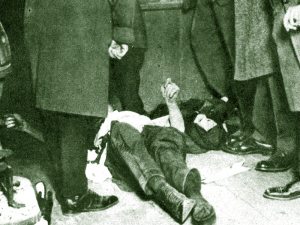
At the scene of Lovett’s murder, a reporter took this shot.
In November 1923, a body was found inside a longshoremen’s warehousing unit/bar at 25 Bridge Street in Brooklyn’s old Irishtown section. It was once the famed saloon and headquarters for the White Hand Gang that had been closed, in all probability, due to Prohibition. The body had blunt trauma to the head and two bullets in the neck. It also had older bullet wounds in the scalp, aged entrance and exit wounds in the chest, abdomen and legs. A veteran of the Brooklyn police force, one William Brosnan identified the body as that of William “Wild Bill” Lovett (1894-1923).
Reporters showed up as soon as word got out and snap shots of the body surrounded by detectives ran in the afternoon editions. Detective Brosnan had been quoted in the newspapers for many years about the gang being the scourge of Brooklyn. When Lovett’s body was being carted to the ambulance car, a reporter overheard Brosnan say, between puffs on his Irish cigar, “Here comes the bride.”
Over the next few days, the sensational life and bloody death of “Wild Bill” sold many copies in the city, upstate in Albany and Rochester and even in newspapers as far away as Michigan and California. The New York Times ran a full page obituary.
“BROOKLYN GANGSTER, COULDN’T ESCAPE FATE”
It was the conclusion to the story of the most popular Irish-American gangster Brooklyn had ever known. For years, newspapers featured him and his antics, from when he shot a man for “pulling a cat’s tail” (apparently he was a cat lover), to when he killed an Italian named Samuel de Angelo, and, probably most notoriously, when he was suspected in the murder of Dinny Meehan to all the other gun charges, fist fights, gang beatings and dead bodies that appeared in vacant lots and underneath the Brooklyn Bridge. No matter how many times the police arrested him, the charges never stuck. And in a place like Irishtown, beating the system was enough to make you a legend. And a legend he was, even if we don’t know much about him today.
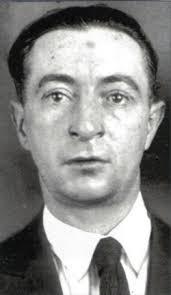
William “Wild Bill” Lovett in a mug shot circa 1921.
He wasn’t always the leader of the White Hand Gang, but in 1918 when he came back from fighting with the 13th Machine Gun Battalion, 77th Infantry Division during World War I and won a medal for Distinguished Service for bravery at the age of 24, he was seen in a new light by the Bridge District “boyos.” The young men in the gang saw him now as a fierce leader who enjoyed killing. For Dinny Meehan, the leader of the gang, Lovett’s being seen as a hero was troubling.
Lovett also began courting Anna Lonergan, who was known as the “Queen of the Irishtown Docks.” By all accounts, Anna was the most beautiful girl Brooklyn had ever known. Her long strawberry blond hair and pretty features endeared her to all the young men in Irishtown and the fact that she only went out with Lovett (eventually marrying him) brought even more greatness upon his reputation.
Not only was Anna beautiful and sought after, but she came from royal dock-gang blood. Her parents originally came from the Lower East Side Irish enclaves. John Lonergan, her father, was a popular bare-knuckle prize fighter in his day and was also known as the muscle behind the Yake Brady Gang, a fierce group who ruled Catherine Street. Mary Lonergan nee Brady was (although difficult to confirm) more than likely the sister of Yake Brady, the gang’s infamous leader.
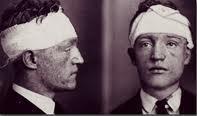
Richard “Pegleg” Lonergan in a Brooklyn mug shot. Apparently wounded.
When Lovett came back from the war, one of the youngest members of Brooklyn’s White Hand Gang was none other than Richie “Pegleg” Lonergan (18 years old in 1918), Anna’s older brother. Lovett and Pegleg were childhood friends, in fact and rumor had it that Lovett was there the day a Brooklyn trolley ran over the eight year old Lonergan, severing his leg at the knee.
With all of this, Lovett had positioned himself as the main challenger to Dinny Meehan, who had ruled the White Hand Gang since 1912 and brought it to great prominence with territory stretching from the Navy Yard all the way down to Red Hook.
These two violent Irish-American young men of the Brooklyn docks, Lovett and Meehan, were at this time chest to chest. On the verge of war for control of the valuable dock “tribute” racket. Lovett had his own followers, about 20 men in the Jay Street Gang. A block over was the White Hand Gang’s headquarters at 25 Bridge Street, though they had more like 100 men, plus an entrenched group of others loyal to Meehan and the Whitehanders.
Somehow they came to an agreement. Lovett’s Jay Street Gang was to pay a weekly tribute to Meehan’s Whitehanders, most eyewitnesses say, though Lovett had his eye on the prize: taking over the leadership of the much larger White Hand Gang.
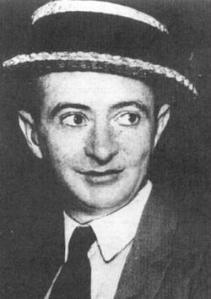
Lovett was never known as a handsome man, in fact some described his ears as being “fawn like” and he had the expression of a demented leprechaun. He was also short and slight of stature, though was known as a powerful fist fighter and quick to the gun like a western gun slinger.
Although Lovett has become known as a ferociously violent gangster who shot men on a whim when drunk (like when someone pulled the cat’s tail), he was quite intelligent when sober and a born leader. Using violence and intimidation on his side in the Brooklyn neighborhoods that were described by the New York Times as being “where life is held as cheaply as anywhere on earth.” But, bowing to the White Hand Gang’s leader for a while was a smart tactic. Especially when a childhood friend of his, Pegleg Lonergan (brother of his intended), was already in the White Hand fold.
Eventually Lovett married Anna and began turning people against Meehan within the gang. Then on March 31, 1920, while Meehan lay in his bed with his wife Sadie, five men walked into his Warren Street brownstone, pushed Meehan’s young son to the side and opened the bedroom door unloading a barrage of bullets into the White Hand Gang leader and wounding his wife in the shoulder.
The police wanted to speak with Lovett about the murder, but he had gone on the lam to Chicago. Some people have speculated that Frankie Yale’s “Black Hand” organization was behind the murder of Meehan (others suspected it was payback for Meehan signing up 100 of his men as scabs during a union walkout on the Chelsea/Hell’s Kitchen docks), but most reputable sources say it was a result of the gang’s infighting. Of note, the famous journalist Meyer Berger wrote in an interview with Anna Lonergan in the 1930s that Anna herself admitted that her late husband Lovett was behind the murder.
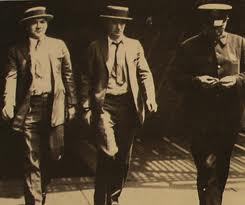
Lovett being escorted by police to the Adams Street Court in 1922.
As a result, Lovett eventually came back from Chicago, beat the rap on the Meehan murder and became the most famous leader of the White Hand Gang, taking up residence above the saloon at 25 Bridge Street that overlooked the pier neighborhood of Irishtown underneath the Manhattan Bridge.
A period of tit-for-tat war then took hold amongst those still loyal to the dead Meehan and Lovett’s men. Many young longshoremen gangsters fell dead in its wake. Yet no one ratted the others out to the police.
Lovett’s infamous binge drinking and alcoholism then takes hold, and when the pressure of being a gang leader reached its height, he promised Anna that he’d quit. So he did, moving to a Ridgefield Park, New Jersey suburb. Leaving the gang’s leadership to his brother-in-law Pegleg Lonergan, it seemed Lovett was ready to sober up and become a settled person.
But one day as he was about to go on a job interview, he instead took the train back to the old Brooklyn dock neighborhoods and went on a binge at the old headquarters at 25 Bridge Street in Irishtown with a one-armed, fellow-World War I veteran named Thomas Flynn. The next morning he was found dead.
In Light of the Diddicoy, the first book in the Auld Irishtown trilogy, Bill Lovett is only 21 years old and has yet to head off to the war. His Jay Street Gang is paying tribute to Meehan and the Whitehanders while they run the Red Hook terminal by the New 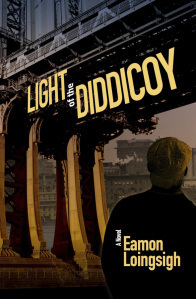 York Dock Company down by the Buttermilk Channel. It is the hardest terminal to run as the neighborhoods inland of Red Hook are jammed with immigrant Italians who want to work on the docks too. Frankie Yale, who runs Brooklyn’s Black Hand organizations, are entrenched in Southern Brooklyn below Red Hook in Gowanus, Bay Ridge, Bensonhurst and Coney Island.
York Dock Company down by the Buttermilk Channel. It is the hardest terminal to run as the neighborhoods inland of Red Hook are jammed with immigrant Italians who want to work on the docks too. Frankie Yale, who runs Brooklyn’s Black Hand organizations, are entrenched in Southern Brooklyn below Red Hook in Gowanus, Bay Ridge, Bensonhurst and Coney Island.
This makes Red Hook the border with the rising Italian organized crime syndicates, a dangerous place where only the meanest leader would suffice to protect the old docks that have been in the hands of the Irish since The Great Hunger sent thousands of Irish peasants to live along the waterfront of Brooklyn. In 1915 and 1916, when Light of the Diddicoy takes place, Red Hook is a war zone where battles occur between Irish and Italians. In this environment, Lovett is at his best.
But the tension mounts between Lovett’s Jay Street Gang and Meehan’s Whitehanders, who he pays tribute too. In between is the teenage Pegleg Lonergan, who feels loyalty toward Meehan for helping his family open a bicycle shop on Bridge Street. But Lovett’s long connection to the family and Anna’s attention force Pegleg to reconsider his loyalties.
A murderous brawl between Lovett’s and Meehan’s followers is on the horizon and the old Irishtown neighborhoods and their plentiful dock rackets are at stake.


March 8, 2014
News & Reviews
John Duddy will be reading from Light of the Diddicoy Wednesday night, 3/12/14 at Le Poisson Rouge.
Three quick things, then on to the reviews. First things first, the Kindle version of Light of the Diddicoy is now available! Yay. If you’re interested, here is the link:
http://www.amazon.com/Light-Diddicoy-Eamon-Loingsigh/dp/0988400898/ref=sr_1_1?ie=UTF8&qid=1394318820&sr=8-1&keywords=Light+of+the+Diddicoy
Secondly, as many of you already know, March 12 is the release party for Light of the Diddicoy along with famous playwright and fellow Three Rooms Press author Richard Vetere’s book The Writers Afterlife. There will be many famous people on stage with both Richard and myself, including journalist & author TJ English, author of Paddy Whacked and The Westies. Also, we will have what Irish Central calls the third most handsome Irishman, John Duddy, who was a former Middle Weight Champion boxer of Northern Ireland and current actor in Colin Broderick’s very interesting play, Father Who. Also in attendance will be John McDonough of WBAI Radio-NYC, host of Radio Free Eireann and beautiful actress Christiane Seidel of Boardwalk Empire along with many, many more. If you’re in town, don’t hesitate to come, IT’S FREE!
Finally, on March 7, I read at the Dire Reading Series at Out of the Blue Art Gallery in Boston and had a great time and sold quite a few copies of Light of the Diddicoy! 
Well, the word is certainly getting out and I feel blessed that it’s a good word. Quite a few reviews have come out and it seems people are enjoying Light of the Diddicoy. As previously mentioned, the Irish Echo & Wild Geese both had very positive things to say and the piece written about why Light of the Diddicoy was written, according to its webmaster/raconteur at LitKicks, received lots of traffic.
The voice of the Irish in New York, Cahir O’Doherty of Irish Central, the website version of the Irish Voice and Irish America Magazine, had rave reviews, stating:
“A vivid portrait of the hardscrabble world of Irish gangs along the Brooklyn waterfront from Greenpoint to Red Hook in the early 20th century, the author captures the still emerging metropolis and its characters through the eyes of wide eyed Irish immigrant Liam Garrity.”
Read more: http://www.irishcentral.com/news/entertainment/A-look-at-books-From-New-York-gangs-to-rural-Limerick-and-modern-cooking.html#ixzz2vPkPNqt8
On top of that, ForeWord, a distributor/publishing trade magazine, said the following:
Here’s a link to read the review in its entirety.
https://www.forewordreviews.com/reviews/light-of-the-diddicoy/
Finally, Kirkus Reviews also says of Light of the Diddicoy:
“Loingsigh’s narrative owes much to historical accounts and family lore; he easily evokes the poverty, pain and hard labor that made up the working experience of the immigrant class in early 20th-century New York, giving the story a grimy verisimilitude.”
Read it here: https://www.kirkusreviews.com/book-reviews/eamon-loingsigh/light-of-the-diddicoy/
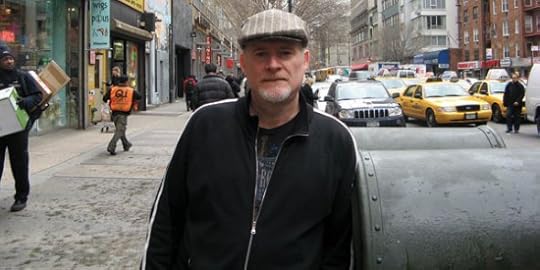
Author & TV personality TJ English will highlight the night and will be doing introductions as well.


February 26, 2014
Irish Echo, LitKicks & Wild Geese
Three very big events happened recently, less than two weeks ahead of the March 12 release party for Light of the Diddicoy.
The Irish Echo has a brilliant feature in their respected print and digital subscription magazine (Click on the screen shot photo below to make bigger).
Also, the oldest, most distinguished literary blog on the internet (yes, they’ve been around since 1994, BEFORE you ever even bought a computer). The piece, entitled “Why I Wrote Light of the Diddicoy” takes the bold stance that this Auld Irishtown trilogy aspires to be (in the ethnic lore of New York City), comparable to Mario Puzo’s great The Godfather.
Read it here:
http://www.litkicks.com/Diddicoy#.Uw4p7_2wju2
Finally, the Irish & Irish diaspora website The New Wild Geese has featured a very positive article of Light of the Diddicoy. Below are is an excerpt from the review and a link to it, if you 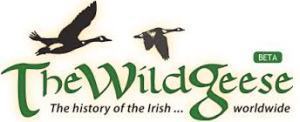 would like to read the whole thing.
would like to read the whole thing.
“It is rich in history and richer in poetry… The characters are beautifully drawn, and one of the great charms of the work is that there is extraordinary feeling in everything he writes, this Eamon Loingsigh… completely perfect and surprisingly satisfying.”
You can read the rest here:
http://thenewwildgeese.com/profiles/blogs/review-light-of-the-diddicoy
In a few days, there should be loads of new reviews and another blog about the bad guy of the Brooklyn waterfront, “Wild Bill” Lovett.
Friday March 7 begins the Diddicoy Tour where I will be reading at the Dire Reading Series in Cambridge, MA in the Boston area.


LitKicks & Irish Echo
Two very big events happened on this 26th day of February, 2014, just two weeks ahead of the March 12 release party for “Light of the Diddicoy.” The Irish Echo has a brilliant feature of me in their respected print and digital subscription magazine.
Also, the oldest, most distinguished literary blog on the internet (yes, they’ve been around since 1994, BEFORE you ever even bought a computer). The piece, entitled “Why I Wrote Light of the Diddicoy” takes the bold stance that this Auld Irishtown trilogy aspires to be (in the ethnic lore of New York City), comparable to Mario Puzo’s great The Godfather.
Read it here:
http://www.litkicks.com/Diddicoy#.Uw4p7_2wju2


February 18, 2014
Gangs of Brooklyn
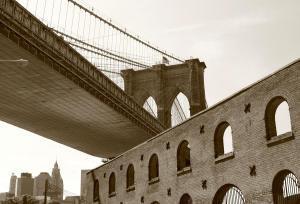 In 1876, the New York Times described the conditions across the East River before the Brooklyn Bridge connected the two cities.
In 1876, the New York Times described the conditions across the East River before the Brooklyn Bridge connected the two cities.
“Desperate outrages by organized gangs of ruffians have been of frequent occurrence in Brooklyn.”
The words “gangs” and “Brooklyn” go hand in hand, though you wouldn’t really know it since the Manhattan gangs, particularly from the Five Points section, have traditionally gotten all the press over the years. In reality, street and dock gangs flourished in Brooklyn in the 19th and early 20th centuries and even outlasted their more popular brothers just a ferry-ride away.
The most famous gangster of all time, in fact, called his home Navy Street just outside of Brooklyn’s Irishtown in what we now call the DUMBO, Vinegar Hill, Navy Yard area. Al Capone, or “Scarface Al” 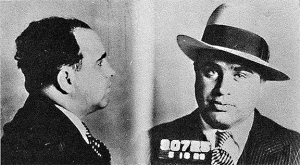 was a young man in a Camorra Italian territory when the approach to the Manhattan Bridge was being built in the neighborhood. Eventually becoming a rising star and the Italian mob’s most important youngster, he was forced out of Brooklyn by the famed Irish dock gang called “The White Hand.” Settling in Chicago, he made his name there instead of in his own hometown.
was a young man in a Camorra Italian territory when the approach to the Manhattan Bridge was being built in the neighborhood. Eventually becoming a rising star and the Italian mob’s most important youngster, he was forced out of Brooklyn by the famed Irish dock gang called “The White Hand.” Settling in Chicago, he made his name there instead of in his own hometown.
Without the world knowing it, Brooklyn has always had the best gangs. And I am here to prove it. For the first time, we have a comprehensive listing of Brooklyn’s gangs unearthing the meanest, rowdiest, drunken, fist-fighting corner loafers, bounty jumpers, bank robbers, highway robbers, political bullies, dock wallopers, pierhouse rats… the most rugged young larrikins of forced tribute and street level insurance the world has not remembered. Until now. With monikers like Joe Grapes, Scabby McCloskey, Pegleg Lonergan, Goose McCue, Pickles Laydon, Skinny Wilson, Yeller Kelly and my own personal favorite, Cute Charlie Red Donnelly.

Due for publication in mid-March 2014, Light of the Diddicoy is the struggle of a 14 year-old Irish immigrant and member of Brooklyn’s White Hand Gang.
During genealogical searches into my own family’s history in Brooklyn’s Irishtown and other neighborhoods, and my research for the historical novel Light of the Diddicoy (Three Rooms Press, March 2014), I found a plethora of heretofore barely known and wholly forgotten gangs that resided in the same neighborhoods and streets that still exist today. In the same warehouses, soap and cardboard box factories that have been converted to condos and in the same brownstones and rowhouses that are now peopled by artists and hipsters.
Because this topic, Gangs of Brooklyn, is so big, I had no choice but to concentrate on the times just after The Great Hunger in Ireland until the beginning of Prohibition, which was right around the time when the dominance of Irish-American street gangs sharply decreased, from around 1845-1919. And also to concentrate on the waterfront neighborhoods from Greenpoint down to Red Hook where the vast majority of Famine Irish settled in Brooklyn.
There are way too many gangs to list here. I had no choice but to leave out many of them such as the White House Gang, Kelsey’s Alley Gang, Forty Acre Gang, Black Coat Gang, Butcher Cart Gang, Red Onion Gang and the Frankie Byrne Gang as well as many more.
But to get started, we’ll give a quick background and then begin at the beginning, which is to say The Great Hunger, when so many desperately poor tenant farming Irish were forced to the waterfront neighborhoods of Brooklyn, which was detailed in a previous post called The Brooklyn Irish.
‘Young Dublin’ and the Scalpeens of Brooklyn
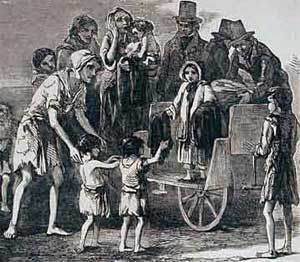
The Great Hunger in Ireland (1845-1852) forced over a million to emigrate to places like Brooklyn where in 1855 there were suddenly close to 60,000 new, destitute and starving immigrants.
Jackson Hollow was a farm owned by the old Brooklyn Schenck family, but afterwards became an area that the heirs of Samuel Jackson fought over. Described differently in different articles, it is generally known as the area currently south of the Navy Yard bordered by Gates Avenue to Flushing Avenue (North to South), then Grand Avenue and Schenck (East to West).
From a February 24, 1858 article in the New York Times, Jackson Hollow’s history was described, “Ten years earlier in 1848… there was an extensive colony of Irish people who had settled on the vacant lots of Fort Greene, which… from the number of pigs and dogs there, was known as ‘Young Dublin.’”
The article then rudely describes how the police made a concerted attack upon this “pigdem” which “rooted” them out. The refugees then moved to Jackson’s Hollow, an area consisting of empty lots and hills at this time. And where eventually, just like in Ireland, they were made to pay rent for squatting there. “Nine out of ten of these shanties have only one room… which does not average over twelve feet square” and “the cradle is seldom empty.”
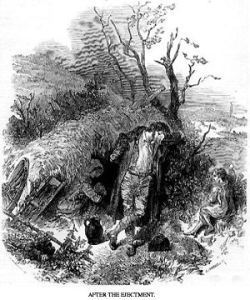
This is what essentially a “scalpeen” was, the most rudimentary shelter that could exist. This sketch could have easily been in Ireland during The Great Hunger, or in Brooklyn’s Young Dublin or Jackson’s Hollow immediately afterward.
Because of lack of employment, or an inability to get work due to their being Irish or Catholic or both, finding work was difficult for men, and if they did find work, there was only part-time available. The mothers and children often were found around City Hall begging for coal.
After the 1840s, Jackson Hollow was known as “one of the worst of Brooklyn’s numerous shanty towns,” according to a May 9th, 1885 Brooklyn Daily Eagle article that looked back to the 1850s and 1860s. These shanties literally were made of tarps or brush that covered a hole in the ground for its numerous squatters. In Ireland during The Great Hunger, these holes in the earth, created after being evicted during the Famine, were called “Scalpeens.” And the similarities are no stretch in imagination. This underlies the intense poverty of the time. In a Dec. 18, 1863 article in the Brooklyn Daily Eagle, it was described thusly “Lying in the very heart of the city, and given over to hogs and cows, and to the squatter sovereigns who have erected wretched shanties upon it.”
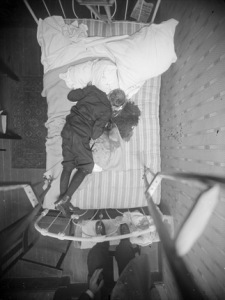
Homicide photo from New York City.
From these humiliating and loathsome origins came the murderous Brooklyn gangs. Alienated in Ireland, their family members dying by the plenty, evicted from their homes, sent as human cargo on coffin ships, only to land in a strange place called “Brooklyn” with no chance to work, hatred for their foreign language and their religion and above all else, starved. Is there any wonder why these Irish immigrants gathered together along ethnic communal lines to beg, borrow and, without blame; steal?
The gangs listed below can be sorted through
by neighborhood. If you do a “Command-F”
search you can look directly for the neighborhood
you are interested in.
Jackson Hollow Gang - (1840s-1901) One of the most prevalent and certainly long-lasting gangs in Brooklyn. The area formerly known as “Jackson Hollow” was the gang’s home turf. An 1858 article in the New York Times, which was essentially a crude census of the “inmates” of the squatters in the area was described thusly, “Upon Grand Avenue, North of Myrtle Avenue, there are 44 shanties having 230 inmates… Between DeKalb and Lafayette Avenues, 20 shanties having 90 inmates… A total of 340 shanties having 1,427 inhabitants of the Hollow… How this large number contrive to subsist at all is a wonder.” It had many gangs, but one in particular dominated from their original arrival in the 1840s due to The Great Hunger in Ireland to the turn of the century when they were still committing crimes in Brooklyn, the Jackson Hollow Gang… In July of 1876, the Jackson Hollow Gang made a big splash in all the New York dailies, including the New York Times, when on the corner of Steuben and Myrtle avenue, they killed on Officer Scott of the Fourth Brooklyn Precinct. When Officer Scott told “a gang of rowdies” to disburse, they verbally abused him and then crushed his skull with a brick thrown at him. Still in operation during the elections of November, 1901 where the gang was planning to perform robberies while the police were busy at the poll stations. One of the gang members William “Solly” Ryan, who was a very well known boxer, beat up and bit officer John Egan at the corner of Bedford Avenue and Fulton Street. A second officer arrived and helped subdue, then arrest Ryan. The gang was described as “an organization composed of the most desperate criminals in the city. Hardly a day passes that some outrage is not traced to the agency of these ruffians. Scott is not the first policeman who has been sent to an untimely grave by this band of outlaws.”
Neighborhoods they roamed: Clinton Hill, Downtown, Irishtown, Navy Yard, Fort Greene, Bedford-Stuyvesant and Williamsburg.
Some of the gang members were: James McQuaid, George W. Sanders, Edward Wheelihan, John Hurley, Edward Hill, Christopher Callahan, James O’Neill, John Conlon, Philip Craddock, Thomas McGuire, Peter McCabe, James Connolly, Thomas Baldwin, John Connors, John Gallagher, William Phalen.
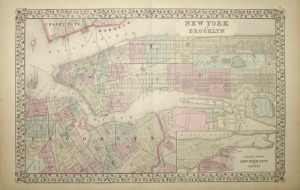
Brooklyn waterfront area (bottom)
Tillary Street Gang – (1849-1881) Originated in the late 1840s, was a politically motivated gang within the Brooklyn Republican Party representing the newly arrived Irish, the gang was described as “the hardest gang in the neighborhood of City Hall.” In the area from Tillary Street to Hudson Avenue in Irishtown, “no policemen dared to patrol that beat alone.” Known for political intimidation, some members were also charged with robbery. First appearing in the newspapers in 1849 at City Hall during a Republican nominations meetings, the Tillary Street Gang, described as “mostly Irishmen” stormed the front row and “had evidently prepared themselves for a row.” Twenty years later in 1869 we find them again amidst a riot between them and another gang in front of a saloon on the corner of Johnson and Navy streets where one James Dunnigan was shot and killed. In 1870, a 19 year-old member of this gang snuck into a lodging at night and when confronted by the occupant, shot at him, then fled. When police went to the young gangster’s home, his mother complained to them about not being able to control him. In 1876, a gang member shot at saloon-keeper Philip Duffy, missing him. After being arrested at a local rookery where the Tillary Street Gang hung out, the gang member was released as Duffy refused to press charges. In 1881, the Tillary Street Gang crowded around the polling places in Brooklyn, which the reporter stated were intimidating pollers that supported Democrat “Boss” McLaughlin. A few years earlier, a Tillary Street Gang member broke up a Fourth Ward Republican Association meeting by storming to the podium and shaking his fist in the face of the association’s president. The meeting was quickly adjourned.
Neighborhoods they roamed: Irishtown, Fulton Street Landing (DUMBO), Navy Yard
Some of the gang members were: James Curry, Robert Berry, Pat Foley, Thomas Howard, James & Mathew Carberry, John Kilroy, Thomas Kilmead.
North Fifth Street Gang – (1860s) A gang that centered its operations around bounty jumping during the Civil War. Members would accept money to go to war so that a richer boy wouldn’t have to, then go AWOL with the money in their pocket.
Neighborhoods they roamed: North Williamsburg
Some of the gang members were: “Punch” Devlin, Jack McCormack a.k.a. “McAlpine.”
Pete Rogers’ Gang – (1860s) Were involved in the robbery and bounty jumping business during the Civil War. A clever, expert burglar, Rogers had a crew that followed him. After robbing a bakery on Union Avenue, Rogers disappeared until he was implicated in a New Jersey robbery, for which he escaped and was never heard from again.
Neighborhoods they roamed: Williamsburg
Some of the gang members were: Pete Rogers, “Matches” Read, Charley McGarvey
The Velvet Caps of Irishtown – (1860s-1870s) Not too much is known about this gang, but what is known can be attributed to Michael J. Shay, a.k.a. The Gas Drip Bard, who often wrote into the Brooklyn Standard Union’s Old-Timers‘ section. He described The Velvet Caps of Irishtown as famous for wearing skin tight pants, like real “dudes” of the era, with blue shirts and caps made of velvet, obviously. In a 1924 article, he wrote about “The Seige of Irishtown” when the Marines were sent into Irishtown in 1873 through the Navy Yard in order to put a stop to the illegal distilleries that made Irish “poteen” and was sold without Uncle Sam’s gaining his tax from it. “Whiskey was the prevailing beverage down there, water was mainly used to wash with,” The Gas Drip Bard proclaimed. So when the Velvet Caps of Irishtown, a local gang close to the distillery owners, found out the Marines were on the way, the gang took a large still and attempted to throw it into the East River until the siege was over. The Marines caught up to them however and a terrible fight ensued for which they had neither the weapons or the numbers the Marines did. The Gas Drip Bard was there when it happened, he says in the 1924 article. No doubt a young and impressionable youth at that time, however. He then repeated the poem written by one Johnny Manning, a previous Irishtown bard and “the leading literary genius of Irishtown in those good old days.” Here’s an excerpt:
“The first place that was taken was in Little Water Street,
The Dutchmen with their axes were a fearful crowd of beats,
They dragged a still out carelessly and threw it on the ground,
Saying ‘Soldiers, watch those Velvet Caps, they’re the boys of Irishtown.’”
(The “Dutchmen” were the Marines under Revenue Officer Silas B. Dutcher)
Neighborhoods they roamed: Irishtown
Battle Row Gang – (1871 -1890) This gang, according to an 1875 article in the Brooklyn Daily Eagle was “composed of the scum of the Fourteenth Ward (Williamsburg).” They were known mostly as “fighters and rowdies” who hung out at “Crow” McGoldrick’s saloon on Union Avenue and North First Street.The Battle Row Gang became famous in the area when Henry Rogers in July of 1871 killed an officer Donohoe and became the first person in many years to suffer the death penalty in Kings County by hanging. In June of that year, two opposing elements of this gang had a horrendous fight where “pistols, knives, fists and slungshots were freely used and the battle raged furiously and unrestrained” for thirty minutes. It started in what we now call Highland Park when one gang pushed a trolley on its side while filled with their opponents. One dying member, Patrick Cash, was asked to name his assailants, to which he replied “I’d die with the name of the fellow in my throat, before I’d give him away.” In 1879, two members of the Battle Row Gang were charged with many thefts from chicken farms in Queens. After stealing them, they sold them to butchers in their Williamsburg neighborhood.
Neighborhoods they roamed: Williamsburg, Bushwick, Queens,
Some of the gang members were: Patrick Cash, “Buck” Doolan, The Powell family, Richard Brien, Edward Kane, Patrick Head, John Pieman, George Fleming, William & James Carberry, John Dougherty, Johnny Reynolds, John Donohoe, Nellie Larkin, Patrick O’Mahony, Patrick Carney.
North Sixth Street Gang – (1870s) Former Forty Thieves gang leader “Skinny” Wilson was one of the leaders of this gang. Some of the elder gang members were also one time members of the Battle Row Gang. They were notorious for burglary and highway robbery. Leaders often spent long stints in Sing Sing, which led to a lot of turnover.
Neighborhoods they roamed: North Williamsburg,
Some of the gang members were: “Skinny” Wilson, “Goose” McCue, “Sugar” Van Wagner, Jack Dunne, Jim Kirwin.
Atlantic Avenue Gang – (1870s) A gang that was “about as hard a looking set of young desperadoes as one could meet in a day’s travel.” Members of this gang were arrested in 1875 for mugging a man on the corner of Atlantic Avenue and Boerum Street.
Neighborhoods they roamed: Cobble Hill
Some of the gang members were: James Harrigan, Thomas Hays, Thomas Thornton, Charles Nesel.
Myrtle Avenue Gang – (1872-1885) Known as simple hooligans who were charged with assaulting many police officers and drunken rowdyism. In 1883 In 1885 one member interrupted a Civil War Veterans picnic at the old High Ground Park (no longer exists) at the corner of Myrtle and Throop. He was “put out” three times, the third time he punched the officer who clubbed and arrested him. The gang assaulted another police officer also that year by throwing paving stones and fighting him while “working the growler” and getting themselves drunk and loud by singing old songs. At one point the gang split in two, the “Dusters” supported by the much bigger Jackson Hollow Gang, and the “Barkers,” who clashed at a saloon at 254 Myrtle Avenue.
Neighborhoods they roamed: Bedford-Stuyvesant, Bushwick,
Some of the gang members were: Joe Grapes, Paddy Burns, Scabby McCloskey, Patrick Lally, Pierce Keating, Maggie McGrath, Dan Callahan, John McCann, John March.
Patchen Avenue Gang – (1876-1881) Burglars & bank robbers. This is not necessarily a Brooklyn gang, though it’s most famous leader “Red” Leary was famously apprehended there by the Pinkerton Agency. In 1876, this gang successfully robbed the Northhampton Bank in Northhampton, Massachusetts of $1.6 million. In 1879, Leary was arrested and by 1881, the rest were rounded up by Robert Pinkerton, son of Allan Pinkerton who created the Pinkerton National Detective Agency.
Neighborhoods they roamed: Bedford-Stuyvesant, Bushwick, Fort Hamilton
Some of the gang members were: “Shang” Draper, “Red” Leary, Robert “Hustling Bob” Scott, Gilbert Yost, Thomas Dunlap, Billy Porter.
The Kettle Gang – (1877-1886) These “youthful highwaymen” in Williamsburg once roamed in an area known as “Pickleville” and were called the Kettle Gang. They got their name from the empty kettles or growlers they carried with them as they sat outside small businesses to beg, annoy and threaten people for enough money to fill their kettles up with beer. This practice, according to the New York Herald in 1885, eventually became known as “working the growler.” In September of 1877, two men were involved in a prize-fight inside a shanty that the gang occupied. August Baxter of Melrose Street and “Wopper” Seidler of Bushwick Avenue were both arrested. A crowd of gangsters and their followers attempted to wrest the two boxers away from police at Bushwick Avenue. There were multiple complaints of this gang mistreating women over the years. In 1879, a man was knifed in a robbery at Bridge and Tillary streets. Police blamed the Kettle Gang. In 1881, three men were raided in their hangout because they “disturbed the whole neighborhood by their orgies.” Which probably meant they were drunk and disorderly, instead of naked and copulating. The Kettle Gang also ran around the Wallabout Bay waterfront area and the Upper East Side of Manhattan where they were known to have long feuds with the police, including throwing rocks and paving stones at them from building tops, known as “Irish confetti.” In 1886, two Kettle Gang members were arrested for offering a Polish man employment, then choked and robbed him.
Neighborhoods they roamed: Williamsburg, Bushwick, Irishtown, Wallabout Bay waterfront, Upper East Side-Manhattan
Some of the gang members were: “Pop” Reilly, “Crook” Connorton, “Snow” McLaughlin, “Rake” Kelly, “Buck” Walsh, “Brock” Harrington, Thomas “Fat Farley” White, Charles Kleka, James McGarra, John Seitz, Robert Garrity, Henry Frank, Andreas Brennis, John Somerendyke, Andrew Wheeler, Edward McGuire, Joseph Betts, Adam Scharf.
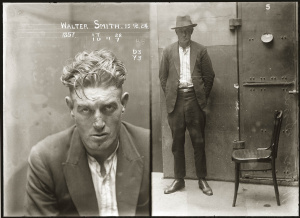
A mug shot from 1900 of a gang member.
Meeker Avenue Gang – (1870s) Their hang out was Sullivan’s Saloon, which was located at the corner of Meeker and Graham Avenues. Members of this gang were also in the North Sixth Street Gang after being driven out of Sullivan’s Saloon, although in 1875, the Brooklyn Daily Eagle reported this gang forced entry into a saloon to get free beer. Some of the elder gang members were once in the Battle Row Gang. One member was charged and convicted for stealing a pair of shoes valued at $2. In 1873, the gang invaded a saloon at 333 Devoe Street and trashed it, taking the owner and his wife as hostage when the police showed up. An Officer Ward’s face and cheek was grazed by a bullet from the gang.
Neighborhoods they roamed: Greenpoint, Bushwick
Some of the gang members were: James Carmen, Daniel Powers, James Kiernan, Abe Gibson, Thomas Brady, Tom McDonald, Jim McGuire
Gang of the Green (1885-1892) – The “green” referred to in this gang was the “open space between Bushwick and Greenpoint,” The New York Herald reported. An off-shoot of the infamous Battle Row Gang, this was a small-time gang known for highway robbery, drunken revelry, fighting with police and muggings who had a headquarters on Union Avenue. In 1885, a gang member simply known as “Bender” attempted to rob a taxi of its cash box. In September of 1886, on the corner of Union and North Second Street at a bar called Fagin & McDonald, one of the owners was challenged to a fight outside by a patron. A donnybrook ensued and five men were arrested. In June of 1891, a drunken gangster brawled with a police officer, kicking him multiple times in the head before eventually being subdued. In November, another gang member robbed two Chinese men who owned a laundry store at 337 Second Street. One of the gang members was stabbed in the neck with a pen-knife, then arrested. After sentencing, the judge said to him, “I know… that you are a member of the notorious Gang of the Green. I want to say that every time a member of your gang is convicted before me, I will give him a long sentence. I consider it my duty to do all that I can to break up the gang.” The next month, another gang member was arrested at the corner of Graham and Driggs for a stabbing. In 1892, a gangster kicked several teeth out of a policemen’s head while being arrested for “assaulting his mother.” In 1896, businessmen and reporters blamed the gang for a riot and ruining seven trolley cars by blocking the tracks, throwing rocks and shooting at the trolley cars. In reality, the violence was spurned by a union strike which didn’t stop the trolley company from hiring scabs to continue service. The gang had been broken up by this time, but the trolley owners had no problem equating unions with the behavior of gangs.
Neighborhoods they roamed: North Williamsburg, Greenpoint, Bushwick
Some of the gang members were: Bender, Charles McDonough, Felix Farmer, James McDonald, Frank Bradley, Jerry Quirk, Timothy Hubbard, Edward Powell, Edward Stillman, George Kennedy, William Mannion.
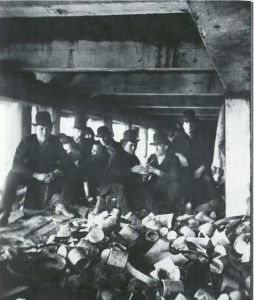
This is an 1887 photo of Manhattan’s “Short Tails” gang, similar to the dock rats of Brooklyn.
Rainmakers Gang (1894 – 1904) – A gang that lived under the docks along the waterfront of North 1st and North 4th streets and in tenement basements. Known as “dock rats,” they stole from factories, barges, railroad freight yards, brawled with police and assaulted and robbed local Jews by throwing bricks and cobblestones at them (hence the moniker “Rainmakers”), then demanding money. In 1900, two members were arrested for asking for a drink at a saloon owned by Samuel Goldstein, then grabbing the whiskey bottle from him. In 1903, this gang was blamed for starting a fire at 288 Wythe Avenue, beating a patrolman and mugging residents for “beer money.” In 1904, the gang started a riot with local “Hebrews” at the corner of Wallabout Street and Harrison Avenue. At the signal, the gang through paving stones and other missiles at “defenseless” Jews. Other local Jews returned the favor and a riot ensued.
Neighborhoods they roamed: North Williamsburg, Greenpoint
Some of the gang members were: Peter “Captain” Mulholland, John Sullivan, James Quinn, Thomas Powers, Michael Moylan, Robert Molloy, Patrick Murray, John Cunningham, John Kiernan, Francis Enright, Harry Fisher, Thomas Sanders, Charles Samm, John Woods, Henry Lehman, John Ricker.
The Dump Gang – (1890s) In March of 1894, seventeen of the gang members were arrested after a raid by police underneath a pier at the garbage dump on the waterfront where they lived during the winter. The officer told a judge they “lived like water rats.” By covering up holes in the pier with canvas and using coal fires, they stayed warm. The leader, “whose proud boast it is that he never worked and never will” along with the others were sentenced at the Tombs Police Court. For food or alcohol, they begged and filled up soda bottles with cheap whiskey or beer growlers. They often stole things like rope from ships along the East River and traded it in for cash. In 1898, a man was beaten to death and had his eyes gouged by this gang.
Neighborhoods they roamed: Newtown Creek, Greenpoint and Long Island City, Queens, Lower East Side-Manhattan.
Some of the gang members were: “Nigger” Jack, “Yeller” Kelly, Patrick Corcoran, William & Dennis Young
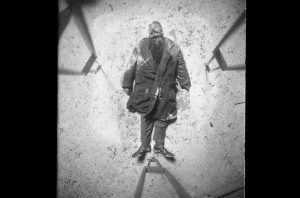
An Italian homicide victim from the White Hand Gang era.
The White Hand Gang – (1905-1925) The most infamous gang of Brooklyn acted as an umbrella organization for other Irish-American gangs that paid tribute to it, including the Jay Street Gang, Red Onion Gang and the Frankie Byrne Gang and others. Known as a dockland gang, they forced longshoremen and local factories, warehouses, ships and pier houses to pay them “tribute.” They were also known for “ginzo hunting” and their hatred of Italians was legendary as they even named their gang in reaction to the Italian “Black Hand.”
Neighborhoods they roamed: Irishtown (headquarters), DUMBO, Navy Yard, Fulton Ferry Landing, Brooklyn Heights, Cobble Hill, Carroll Gardens, Red Hook.
Some of the gang members were: “Wild” Bill Lovett, “Pegleg” Lonergan, Dinny Meehan, “The Swede” Finnigan, “Cute Charlie, Red” Donnelly, “Non” Connors, Matty Martin, Tim & James Quilty, Petey Behan, Harry Reynolds, Garry Barry, Philip Large, Mickey Kane, Eddie MaGuire, Eddie Lynch.
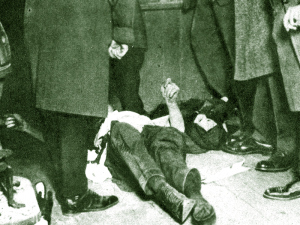
Wild Bill Lovett dead on arrival, 1923.
The Jay Street Gang – (1904-1914) Originally an Irishtown gang from the 1870s who were a collection of “vulgar bruisers,” according to the Brooklyn Daily Union in June, 1871. “Wild” Bill Lovett was a young leader in the 1910s. Although he was small, he was a ferocious fist-fighter who commanded a group of about 20 young longshoremen along the Brooklyn waterfront in the mid 1910s. They forced other laborers to pay “tribute” to them after a day’s hard working, or forced them to pay for the right to work. They also were known to shake down gambling joints or warehouses and ship captains. Eventually Lovett (although never charged) probably killed Dinny Meehan, the leader of the much bigger White Hand Gang, who Lovett was more than likely paying tribute to. Lovett then took over the White Handers after going on the lam for a while in Chicago. Some doubt whether he ever accepted Meehan as a leader in the first place, though most believe the Jay Street Gang was one of the many Brooklyn waterfront gangs that lived under the White Hand umbrella.
Neighborhoods they roamed: Irishtown (headquarters), DUMBO, Navy Yard, Fulton Ferry Landing, Brooklyn Heights, Bedford-Stuyvesant.
Some of the gang members were:“Wild” Bill Lovett, John Lonergan, Richie “Pegleg” Lonergan, “Dago” Tom Montague, “Cute” Charlie “Red” Donnelly, “Pickles” Laydon, Jim Healy, Arthur & Charlie Johnson, Belle Marion, Daniel Hustis, Charles Stanton.



